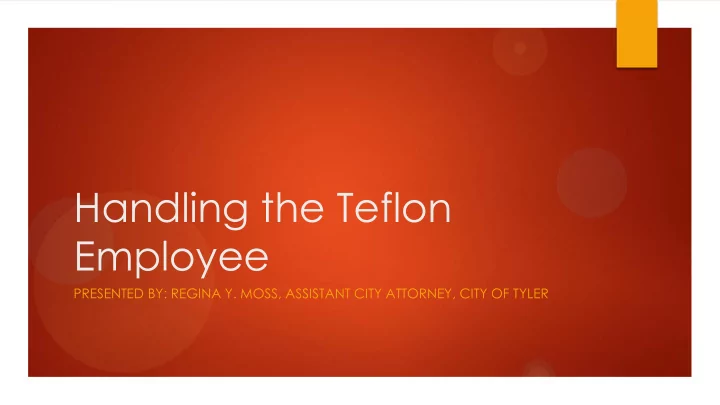

Handling the Teflon Employee PRESENTED BY: REGINA Y. MOSS, ASSISTANT CITY ATTORNEY, CITY OF TYLER
What to Do When You’ve Created a “Teflon Man” By Failing to Deal with a Difficult Employee? I. Conduct an Organizational Assessment. II. Understand the Consequences of Failing to Act. III. Develop a Plan for Moving Forward. III. Benefits of Timely and Appropriate Employee Discipline.
The Scenario…. What Manner of Bad Employee Are We Dealing With? Ruthless Leader Disruptive Dolly Negative Nelly Absent Anne Dishonest Dale Profane Peter Cheating Chad Outlandish Ollie Rule-skirting Ruby Menacing Melanie Time-stealing Tom Rumor Rick Condescending Cindy Lying Louise Joking Jim
Conduct An Organizational Assessment. How Did We Get Here? Overlooking poor behavior because of perceived “value add.” Actually spawns loss by damaging productivity, morale and creative abilities of subordinates and other employees. Making excuses for poor behavior. “Well that’s just how he is ,” “She’s just very direct and no one should take it personal,” “He’s tough, but good for our bottom line,” etc .
Organizational Assessment Cont. How Did We Get Here? Turning a blind eye- knowing that there is a problem but failing to take any action because no one has actually made a formal complaint. Status quo- easier to look past habitual bad behaviors that have gone uncorrected. Ignoring reality- often no formal complaint has been made because would-be complainants may be afraid of reprisal from the bad actor. The Blame Game. Allowing the bad actor to deflect and place the blame on others. Avoiding consequences of own bad conduct. Bad leaders may remove/terminate subordinate employees from their team to show they are “handling the problem.” Failure to acknowledge that their own poor leadership or bad behavior led to the negative outcome.
Create a Plan For Moving Forward. Where Do We Go From Here? Once you have identified that there is in fact a problem you must decide what to do next AND TAKE ACTION. Take steps to rehabilitate the employee: E.g., counseling and coaching; targeted training, performance improvement plan (PIP); mentorship; different assignment; new/change in work group, etc. Document, document, document….. Formal disciplinary action: E.g., oral reprimand, letter of reprimand, demotion, suspension without pay, termination, etc. Document, document, document…… Communicate a change in organizational culture: Spread the word- let employees know expectations moving forward; clear policies concerning acceptable behavior and what will and will not be tolerated, etc.
Failure to Take Action. What Are the Real Consequences? One bad apple truly can spoil the whole bunch. Left unchecked a bad actor (especially those in leadership roles) actually model how not to act. Colleagues and subordinates of bad actors are watching- potentially creating a whole new generation of bad actors. Sends the message that the organization does not care. Failure to correct bad actors devalues others in the organization and sends the message that the organization does not care enough to protect its employees from bad actors. Hinders litigation defense in employment actions. A record of prior discipline strengthens an employer’s defense or allows them to avoid litigation (and associated costs) all together. No matter the type of case, an employee will almost always argue that adverse employment action was pre- textual, discriminatory or otherwise violated their rights. To support their argument an employee will inevitably argue they were unaware of the claimed bad conduct and that they had not previously been disciplined for behavioral issues or the same conduct.
Notable Cases Tatum v. Southern Co. Servs. Inc., 930 F.3d 709 (5th Cir. 2019)(affirming grant of summary judgment in employer’s favor where, in the defense of alleged claims of interference and retaliation in violation of the Family Medical Leave Act, the employer was able to show employee’s discharge was not retaliatory and was based on legitimate reasons including employee’s continued inappropriate behavior towards his managers and coworkers despite years of counseling and coaching, and failure to timely report a potential safety concern). Mauder v. Metro. Transit Auth., 446 F.3d 574 (5th Cir. 2006) (finding no evidence of retaliation where the employer’s documented record through corrective action memos as well as verbal and written reprimands showed employee had been warned, prior to his termination, regarding the need to improve his attitude and availability).
Notable Cases Cont. Richardson v. Monitronics Int’l, Inc. , 434 F.3d 327, 336 (5th Cir. 2005) (“[a]n employer’s failure to follow its own policies may be probative of discriminatory intent”) . Graham v. Arctic Zone Iceplex, LLC , 930 F.3d 926, 929 (7th Cir. 2019) (finding that an employer does not forfeit the right to discipline an employee for the same type of conduct that it previously did not correct stating that the employer’s “decision to let something slide without a formal response does not mean that it went unnoticed or untallied. And even minor grievances can accumulate into a record that justifies terminations. ”) .
Recommend
More recommend